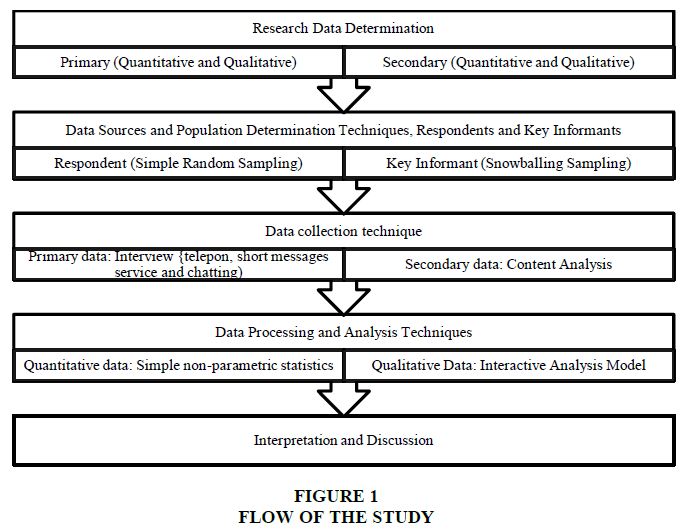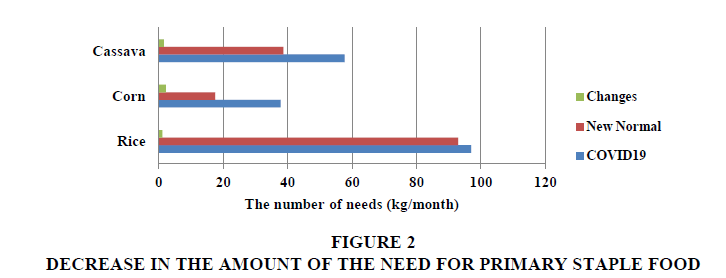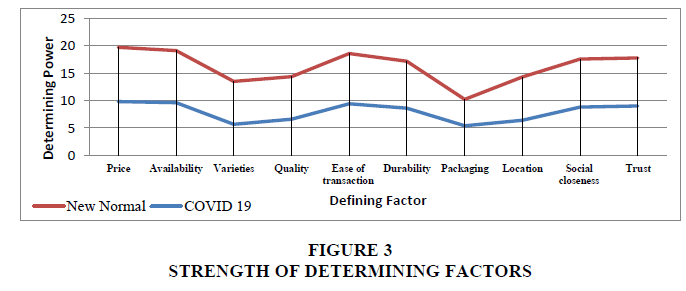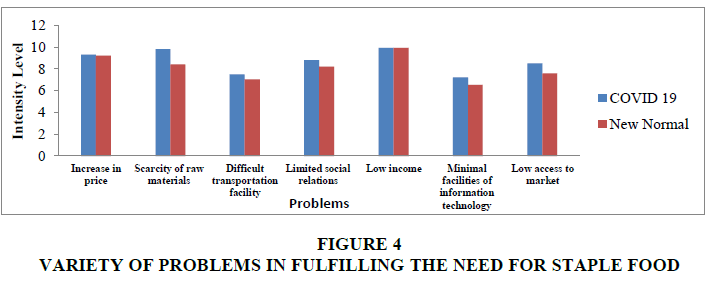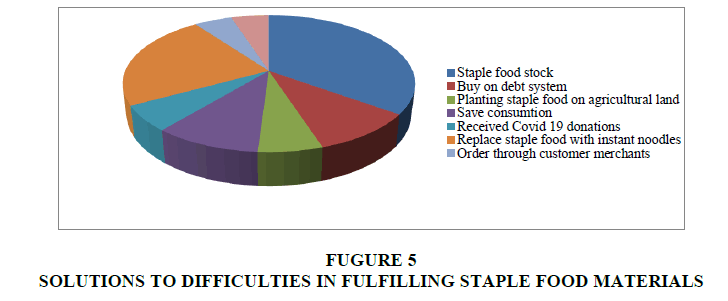Research Article: 2022 Vol: 21 Issue: 1
Functional and Economic Benefits of Leading Food in the Time of the Covid 19 and New Normal Pandemic
Dumasari Dumasari, Muhammadiyah Purwokerto University
Citation Information: Dumasari, D. (2021). Functional and economic benefits of leading food in the time of the covid 19 and new normal pandemic. Academy of Strategic Management Journal, 21(1), 1-12.
Abstract
One of the serious problems of the COVID 19 pandemics and New Normal is the scarcity and increase in staple food price. This problem motivated the research to be carried out in Banyumas Regency, Central Java Province, Indonesia. The research method is a descriptive survey. The results showed that most household increased their needs for superior staple food during the pandemic and New Normal. The highest demand for superior staple food is rice. Corn and cassava are also needed by a small proportion of the household. The increase occurred because of the panic reaction of the community. The panic euphoria of rice's priority staple food encourages consumers to buy in extraordinary amounts. Various problems hinder, ranging from decreased income, rising prices, decreasing supply scarcity, minimal market access, limited social relations, difficult transportation and minimal information technology. Fulfilment of the increase in the need for superior staple food is carried out through stock, replacing staple foods with instant noodles, buying with loans, and reduce consumption. A small proportion of household chose to grow their food, received COVID 19 donations, ordered via customer merchants and order delivery. The three superior staple foods provide functional benefits for consumption, stock, and donations. Yhe economic benefits for merchandise. Generousity of household is getting stronger. Part of the stock of superior staple food is distributed to residents in need. Generousity is the basis for developing a humanitarian movement to build a resilient food system.
Keywords
COVID 19 Pandemic, Food Security, Functional and Economic Benefits, Staple Food, Staple Food Panic.
Introduction
The staple food is one of the most vital needs in human life. Therefore, the fulfillment of staple food needs cannot be postponed. The primary reason behind when considering staple foodstuffs is the determinant of human life sustainability. Staple foodstuffs also function as a determinant of the quality of human resources. Disturbances that hinder the fulfillment of the need for staple food can result in a lack of ideal nutrition so that the health status is weak and the quality of human resources decreases.
The sources of the disturbance are varied. One of the sources of disruption to the fulfillment of staple foods that have occurred since the end of 2019 is the COVID 19 pandemic as a global crisis (Galanakis, 2020; Knorr & Khoo, 2020). The pandemic has had immediate, severe consequences and caused human health problems worldwide (Stephens et al., 2020; Udmale et al., 2020). Effects of Pandemic Corona Virus SARS-CoV 2 COVID 19 is a disease with the severe acute respiratory syndrome and causes health problems and death in large numbers of people in various countries. The COVID 19 pandemic has profoundly affected the global economy and worldwide food trade (Mayasari et al., 2020; Ma et al., 2021).
The effects of the pandemic are vast and dilemmatic regarding all aspects of human life. Disruption to the food safety system, either directly or indirectly, is one consequence that no one can avoid. The risk of the complexity of COVID 19 due to worker restrictions, including in the agricultural sector, has disrupted the food production process. The shift in time for the production process is prone to disrupt food safety as a critical determinant of health. The COVID 19 issue on food safety requires a One Health approach with the concept of managing risk cost-effectively and coordinated cross-sectoral investment in human, environmental and animal health (Mardones et al., 2020).
The pandemic has spread rapidly throughout the world since the first cases detected in Wuhan, China, in December 2019. Governments in various countries have established strict regulations and radical measures to prevent the transmission of COVID 19. The various forms of human life activities have changed drastically. Healthy and clean living behaviour targets the body's immunity in preventing COVID 19 transmission. Behaviour in consuming food also changes. Several foodstuffs that are believed to increase the body's immunity have increased demand in the market. The pandemic has also affected eating habits and food purchasing behaviour (Yilmaz et al., 2020).
Literature Review
The strategic value of staple foods proved to be high during the pandemic until the New Normal period. Alternative solutions are needed to overcome various challenges in maintaining community staple food security, especially at the household level (Knorr & Khoo, 2020). A more resilient food system in the agricultural sector is urgent and crucially built to anticipate the future Covid Pandemic. This resilient food system is integrated with other sectors to form a series of supporting factors conducive to the production process, food supply chain, nutritional security, healthy food accessibility, health education and communication on safety and humane food preparation. A resilient food system also ensures food safety for residents during prolonged quarantine (Galanakis, 2020; Al-doori et al., 2021). Assurance regarding confidence in the food supply is also an essential part of the concept of a resilient food system.
The existence of the concept of a resilient food system has strategic value in increasing immunity so that the body is strong against the attack of the COVID 19 virus. Public knowledge about the adequacy and safety of nutritious and hygienic food is needed to support a resilient food system (Duda-Chodak et al., 2020). A dramatic problem in the pandemic has seen a significant decrease in income, especially those affected by low and middle-income citizens (Carducci et al., 2021).). These residents have difficulty obtaining nutritious and hygienic food. The further effect of this problem is increased food insecurity, decreased quality diets, deficiency of micronutrients and other forms that lead to malnutrition and decreased immunity. The difficulty in meeting food needs, including those of an essential nature, was also caused by disrupted supply chains during the pandemic (Aday & Aday, 2020). Food distribution is hampered to consumers. Restrictions affect the workers' movements, changes in consumer demand, closure of food production facilities, restrictions on food trade policies, and financial pressures in the food supply chain (Aday & Aday, 2020). Therefore, the government needs to regulate and facilitate the movement of workers and agribusiness products to support a resilient food system. The supply chain must also be flexible and adaptive to adapt to the conditions of the pandemic.
The impact of COVID 19 on the agricultural economy is genuine in several aspects: crop production, the supply chain for agricultural products, livestock production, farmer income, agricultural work, development of crops with economic value, a model for selling agricultural products, development of recreational agriculture and trade in agricultural products (Pan et al., 2020; Barman et al., 2021; Rejeb et al., 2020; Zayed et al., 2021). However, the agricultural sector could survive as a livelihood for the majority of the population and a source of food for both rural and urban residents during the COVID 19 crisis (Boughton et al., 2021).
Starting from a series of research results, it is increasingly believed that the role of the agricultural sector is indeed essential in handling the effects of the Covid Pandemic 19. With various disruptions due to COVID 19 effect on farmer performance, farm productivity, supply, supply chains, and distribution of agricultural products will undoubtedly result in various difficulties for consumers. In meeting the needs, especially staple foodstuffs. Even though it is known that staple food is vital for human life, by considering these conditions, research on the factual conditions of consumers in meeting their basic food needs during the pandemic to the new normal was carried out in-depth. The results of this study are essential as valuable information for consideration in the formulation of agricultural policies with the challenges of the pandemic in the future.
Material and Methodology
This research uses a descriptive survey method. The research design uses a combination approach between quantitative and qualitative (Creswell, 1994). The location of the research was carried out deliberately in Banyumas Regency, Central Java Province, Indonesia. The selected location is the production centre for staple foods of rice, maize, and cassava was in Central Java Province. However, during the pandemic until the New Normal period, the local community experienced problems in meeting their basic food needs. This problem is related to a dilemma because, on the one hand, there is an increase in the need for staple food. Meanwhile, on the other hand, there is an apparent scarcity of basic foodstuffs due to the incidence of market closures, limited transportation, lockdown areas, restrictions on travelling outside the home, maintaining distance and isolation of areas.
Given the pandemic and New Normal conditions that still impose social distancing restrictions, the study population includes all households with telephone facilities in the Banyumas Regency area. The technique of determining respondents was carried out by simple random sampling. Respondents were randomly selected from the 2020 telephone subscriber book list. If the selected respondent did not respond, then contact with other respondents was random. Respondents who are successfully contacted will be asked to be willing to interview about research problems. If the respondent does not wish to be interviewed, then proceed to the next random respondent. The number of respondents is not limited proportionally. Telephone interviews were terminated when the data collected met the requirements to answer problem formulations in full and in-depth. A respondent is not only interviewed by telephone. However, the second and subsequent interviews were carried out with short message service, calls and chat via WhatsApp.
The types of data collected are primary and secondary data. Primary data were collected through interviews with selected respondents. Interviews took place using telephone and WhatsApp call facilities. The other primary data collection techniques are through the short message service (SMS) and chat using WhatsApp. The interviews conducted to refer to a list of questions compiled on a structured questionnaire. Secondary data was collected by browsing news in newspapers and online social media, which contained information on the problem of fulfilling staple foodstuffs for consumers in the Banyumas Regency area. Secondary data were also obtained from literature relevant to the research theme. The flow of research activities can be seen in Figure 1.
All data collected is then processed and analyzed. So that it can be described in detail. Data processing techniques are carried out quantitatively and qualitatively. A series of data processing and analysis activities were carried out while in the field. Data processing time takes place at the same time as data collection. Quantitative data were analyzed using descriptive statistical techniques such as percentage, scoring, mean, tabulation and graphic display. The analysis technique of processed qualitative data is carried out using an Interactive Model of Analysis (Miles & Huberman, 1991). The results of data analysis are interpreted, discussed and then presented in a systematic descriptive description.
Result and Discussion
The COVID 19 pandemic has not subsided worldwide even though the New Normal period has been established for several months. The pandemic caused severe shocks to the economy and social costs due to strict restrictions on human movement, and this condition affected the functioning of the agricultural and food systems (Stephens et al., 2020). The COVID 19 pandemic disrupted food supply chains worldwide, and this problem requires solutions to improve the food network system, innovation technology, and political determination (Torero, 2020). The agri-food economy is disrupted because the demand for foodstuffs decreases in terms of restaurant services and other commercial food industries that are difficult to produce (Stephens et al., 2020). However, on the other hand, it turns out that the demand for staple foodstuffs has increased, especially from consumer households. According to The World Bank (2021), the increase in staple foodstuffs from households has increased even though global prices have risen to nearly 20 per cent in the last year (January 2020-January 2021) and are consistent with movements in other commodity prices. Increased confidence in the supply and demand prospects has contributed to reduced market volatility and put pressure on grain prices (rice, wheat, corn and soybeans).
The increase in staple food prices and decreased household income during the pandemic to the New Normal is a dilemma. The main risk is that food security is compromised because higher retail prices, coupled with reduced incomes, mean that more households have to reduce the quantity and quality of food consumption. The above statement turns out to be different from the findings of our research, which prove that there is an increase in the demand for staple food in consumer households in Banyumas, Central Java, Indonesia. This increase is a reaction from food panicking since the emergence of the pandemic until the New Normal period. The increase in the need for superior staple food shows a panic reaction to food scarcity and decreased immunity.
Consumers' needs for superior staple food during the pandemic to the New Normal are no different. It is just that there is a shift in the number of needs. Shifts also occur in the functional and economic benefits of superior staple foods. The main staple food categories include rice, corn and cassava. The selection of staple food favored by consumer households has specific conditions. Some of these requirements are: basic foodstuffs that are habitual for daily consumption, a source of nutrition, a source of immunity, easy to obtain, low cost, safe for health, practically easy to process, can be stored as food stock, durable and easy to consume.
The selection of staple foodstuffs is not only based on functional and economic benefits. However, additional criteria are considered valuable as material for consideration in dealing with the typical pandemic, namely the source of immunity. Respondent households are aware that the adequacy of staple food consumption is very meaningful to strengthen immunity so that it is not susceptible to severe COVID 19. Household respondents, on average, are aware that maintaining health during the COVID 19 Pandemic to New Normal is something valuable. The cleanliness of the food consumed is taken seriously by the respondents.
The amount of staple food needs for rice has increased significantly during the pandemic. Likewise, cassava and corn have experienced an increase. When entering the New Normal period, the need for the three types of staple food decreased. The need for corn and cassava decreased dramatically. The decrease in rice was only slight. This decrease in need is a reaction of household respondents to the increasingly relaxed COVID 19 protocol rules. There is less anxiety about the scarcity of staple foods. There were also respondents' households who decided to reduce their food reserves for corn and cassava because of the difficulty of storing them for a long time. The change in the amount of the three basic food needs during the pandemic to the New Normal is shown in Figure 2.
During the pandemic to the New Normal period, several factors determined the fulfillment of basic food needs. The influence of each factor is not much difference between the pandemic and the New Normal period. Price, availability and ease of obtaining staple foodstuffs are the three most dominant factors affecting respondent households in making decisions to buy staple foodstuffs. The price that they are interested in is affordable to the respondent's purchasing power. The desire to immediately buy basic foodstuffs arises when availability is running low. During the pandemic, the availability of basic foodstuffs was made safe. Respondents also chose an easy way to get basic foodstuffs. Government regulations that have closed markets and certain areas have restricted the movement of respondents in buying staple foodstuffs. During the New Normal period, there were also dominant influences from these three factors.
Limited social mobility during the pandemic and New Normal has created close social relations at a distance from fellow citizens. However, in fulfilling the need for staple food, there is a tendency for respondents to choose places for traders who are known as customers as trusted shopping places. The location of traders and shopping places is relatively close to the respondent's place of residence. Therefore, the closeness of social relations, mutual trust and location of shopping places are among the dominant actors influencing the respondent's household in decreasing the need for staple food.
The medium determining factors for the fulfillment of staple foodstuffs are quality, variety and packaging. Some of the respondent's households still have time to choose the quality and variety of staple foodstuffs. The packaging factor also includes the part that affects the respondent's ability to meet the needs of basic foodstuffs. The strength of the determinants of all these factors is shown in Figure 3.
Some of the problems faced by the respondents' households when meeting their basic food needs are related to decreased income. The majority (> 75 per cent) of respondents admitted that their income decreased during the COVID 19 Pandemic until they entered the New Normal. The respondent's productive activities are increasingly limited. Not even a small number of respondents experienced termination of employment. Respondents who manage food and drink trading businesses in restaurants or street food also collapsed and were stopped. The cost of meeting basic food needs is taken from savings or borrowing from banks, cooperatives and other savings and loan institutions.
Another severe problem during COVID 19 is related to the scarcity of staple foods. Staple foodstuffs often suddenly disappear from the market. Many respondents find it difficult to buy rice. Respondents' anxiety was high when facing the problem of scarcity of staple rice during the COVID 19 Pandemic. After the New Normal, the problem of rice scarcity gradually subsided. However, respondents still tried to protect the safety of the staple food rice.
The increase in staple food price, especially rice, occurred during the COVID 19 Pandemic. High prices also persisted during the New Normal period. This price increase made it difficult for some of the respondent's households to buy rice. The increase in rice prices was due to availability in scarce markets while demand from consumers increased. Several respondents explained that the rice disappeared because of the behaviour of certain parties who took excessive stock action.
Another problem that is no less important is the limitations of respondents in making social relationships with traders of rice, corn and cassava. Awareness of the COVID 19 Protocol regulations keeps social distancing between residents. Respondents' access to markets is getting weaker. Transportation also did not go smoothly. Respondents prefer to stay in their own house. The fear of being exposed to COVID 19 causes residents to maintain strict social distancing. Likewise, problems in the lack of information technology facilities trapped some respondents into the trap of disconnection and interaction. This problem gets worse when respondents experience limited costs for purchasing pulses. The various problems of the respondent's household in meeting their basic food needs during the COVID 19 to the New Normal are detailed in Figure 4.
Materials
The respondents have done various alternative solutions in connection with the resolution of various problems listed in Figure 4. Respondents stated that the solution that is considered the easiest to do is to replace the staple foods of rice, corn and cassava with instant noodles. Most respondents stock instant noodles. This type of food is a substitute for rice at lunch and dinner. The reason for choosing instant noodles is that the price is relatively low, practical, and complete with seasoning.
Another solution that respondents are interested in is to stock up for staple food recommendations. Not only rice was stocked by the respondents. However, some respondents also keep corn and cassava stock. Staple food stock action is one form of respondent survival strategy. Some other forms of solutions performed by respondents are listed in Figure 5.
The increase in the number of needs for the three types of staple foodstuffs is due to the respondent's household having various functional and economic benefits. Functional benefits, namely superior staple food consumed directly by family members. The increase in the amount of consumption is due to household members living together in the house longer. This condition is due to government regulations imposing lockdowns, large-scale social restrictions, working from home, wearing masks, increasing immunity, washing hands and social distancing.
Another functional benefit is in the form of stock preparation for staple food reserves. Staple food stocks, especially rice, are a survival strategy in maintaining family food security. The increase in the need for staple food during the COVID 19 pandemic has motivated households to cover up concerns about the scarcity of staple foods. The pandemic is considered an emergency event because the local government carries out a market lockdown at certain times, causing anxiety in the respondent's household that it will be difficult to get basic foodstuffs. A small number of households also did the corn and cassava food stock measures. It is just that the stocks of maize and cassava are carried out by households who work as farmers. The farmers' households partially store the maize and cassava yields as staple food reserves.
The functional benefit of the three types of superior foodstuffs during the COVID 19 pandemic is that the behaviour of the respondent's household has increased in giving donations to help other residents with a weak economy. The benefit of sharing is an act of social care and tolerance that increased during the COVID 19 Pandemic. This functional benefit goes hand in hand with the risk of limited behaviour to channel passion in social gregariousness. The COVID 19 pandemic limits human instincts as social beings who always want to mingle in various life interests. Residents who receive assistance come from communities affected by work relationships or loss of work due to limited economic opportunities or interruption of the production process, such as street food traders, restaurant waiters, hotel employees, drivers, cleaners, transportation workers, industrial employees, and others.
The three types of staple food provide economic benefits for a small number of respondent households. The economic motive encourages the actions of specific respondent households to sell some of the staple foodstuffs that are stored to residents in need. The offer of staple food, especially rice, is carried out through promotion through social media. Transactions occur using an online system or pay on the spot with a delivery order system.
The intensity of the three staples' various functional and economic benefits decreased in several respondent households after entering the New Normal period. According to the COVID 19 protocol, regulations that were increasingly relaxed during the New Normal period resulted in changes in survival behaviour in most respondent households. Staple food stocks are reduced and stopped by part of the respondent's household. The frequency of giving rice donations also decreased. The respondent's household still gives corn and cassava to other residents who are in need in rural areas. The shift in the intensity of functional and economic benefits from the three staple foodstuffs from the COVID 19 pandemic to the New Normal is observed in Table 1. The variety of functional and economic benefits and the decline conditions for the three types of superior staple food can be seen in Table 1.
| Table 1 Variety Of Functional And Economic Benefits Of Leading Staple Food Materials |
||||||||
|---|---|---|---|---|---|---|---|---|
| Superior food types | Functional and Economic Benefits (%) | |||||||
| COVID 19 | New Normal | |||||||
| Consumption | Stock | Commodity | Donation | Consumption | Stock | Commodity | Donation | |
| Rice | 100 | 87 | 28 | 47 | 100 | 52 | 28 | 32 |
| Corn | 100 | 25 | 27 | 6 | 100 | 15 | 12 | 5 |
| Cassava | 100 | 17 | 27 | 6 | 100 | 8 | 12 | 5 |
The increase in the fulfilment of the respondent's household needs for staple food during the pandemic to New Normal was motivated by a serious panic reaction. The increase in staple food price is not a problem for the respondent's household. Various forms of survival strategies are carried out so that the respondent's household can obtain functional and economic benefits from the staple foodstuffs of rice, corn and cassava.
Food panic occurs due to strict rules for preventing the transmission of COVID 19 in isolation and lockdown, which makes anxiety over food safety a determinant of high health problems (Chiwona-Karltun et al., 2021). It is also feared that the limitation of social distancing during the pandemic will result in food insecurity which can lead to nutritional deficiencies that weakens the body's immunity (Elsahoryi et al., 2020). This includes what prompted respondents to panic in preparing staple food stocks during home quarantine. The severe disruption of the pandemic to global food security motivated the emergence of a humanitarian movement to distribute food aid to people experiencing decreased income or layoffs and others (Udmale et al., 2020).
Respondent households also carried out humanitarian movements in sharing staple food. Respondent households diligently distribute part of the staple food stock to be donated to disadvantaged residents. Generous behaviour is a part that needs to be strengthened during the food crisis during the pandemic to New Normal. Generous behaviour can also improve resilient food systems in communities affected by disruption in the supply and distribution of staple foodstuffs. Efforts to strengthen generous behaviour need to be supported by increasing awareness, motivation, collectivity, solidarity, cooperation, social cohesion, community sentiment and sensitivity.
Generous behaviour requires productive, creative and innovative actions. These efforts can also support the development of self-reliance and community empowerment based on local resources (Dumasari et., 2019; Dumasari et al., 2020). The development of a mitigation mechanism system based on local resources needs to be built and adopted to sustain the livelihoods of people experiencing a pandemic (Workie et al., 2020; Rejeb et al., 2020; Alam & Khatun, 2021). In addition to a diverse and local resource-based livelihood mitigation system, of course the development and empowerment of people who are prone to job loss has always been a priority. This is important given that their food security system was fragile during a pandemic. Sensitive management is needed to improve the function of basic food security in households to be ready to face the pandemic (Khoshroo et al., 2018; Dumasari et al., 2021). Therefore, community empowerment needs to emphasize food self-sufficiency by utilizing the principle of generosity.
Conclusion and Recommendation
Staple food safety turned out to be one of the priority decisions, and the respondent's household took actions during the pandemic to New Normal. Restrictions on social distancing, quarantine, and lockdown to prevent coronavirus transmission have created complex problems in the production, distribution and supply chain of staple foods. These various disruptions led to supply shortages, distribution delays and an increase in the price of superior staple foods.
The consequence that is difficult to avoid is panic in the staple food. The increase in the need for superior staple food has increased in most respondent households. The respondent's household purchases staple food in large quantities even though the price is rising. Superior staple food has functional and economic benefits during the pandemic and New Normal. Functional benefits are intended for consumption, stock and donations. The economic benefit of the staple food received by the respondents is selling part of the stock to other consumers.
The scarcity of staple foods during the pandemic and New Normal is a severe problem that is urgent and crucial to be handled by various parties. The government and the community help each other and build a resilient food system. The existence of generous behaviour that is getting stronger during the pandemic and New Normal needs to be utilized and managed to support the realization of a robust food system.
Acknowledgement
This article is compiled based on the results of research funded by the Muhammadiyah University of Purwokerto. Therefore, thanks to the Chancellor, Vice Rector IV, Chair of the Institute for Research and Community Service, Muhammadiyah Purwokerto University for all material assistance to facilitate research. This research scheme includes a professor acceleration grant.
References
Creswell. (1994). Research design qualitative and quantitative approaches. In Thousand Oaks, Sage Publication, London.
Dumasari, D., Dharmawan, B., Budiningsih, S., & Santosa, I. (2021). Sensitivity-based adaptive management in empowering quality cococraft craftmen. International Journal of Entrepreneurship, 25(1), 1-12.
Khoshroo, A., Emrouznejad, A., Ghaffarizadeh, A., Kasraei, M., & Omid, M. (2018). Sensitivity analysis of energy inputs in crop production using artificial neural networks. Journal of Cleaner Production, 197, 992-998.
Mayasari, N.R., Khanh, D., Ho, N., Lundy, D.J., Skalny, A.V, Tinkov, A.A., Teng, I., Wu, M., Faradina, A., Zaki, A., Mohammed, M., Park, J.M., Ngu, Y.J., Alin, S., Shofia, N.M., & Chang, J. (2020). Impacts of the COVID-19 pandemic on food security and diet-related lifestyle behaviors: An analytical study of google trends-based query volumes. Nutrients, 12(3103), 1-12.
The World Bank. (2021). Food Security and COVID-19.
Torero, M. (2020). Without food, there can be no exit from the pandemic. Nature, 580(7805), 588-589.
Zayed, N.M., Khan, S., Shahi, S.K., & Afrin, M. (2021). Impact of Coronavirus (COVID-19) on the World Economy, 2020: A Conceptual Analysis. Journal of Humanities, Arts and Social Science, 5(1), 1-5.
